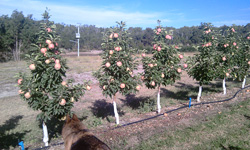Eight years after the discovery of a Cripps Pink sport on the property of Terry and Dianne Fogliani (apple and pear growers near Donnybrook, WA), the commercial potential of Pink Belle™ is being realised.
 Pink Belle™
Pink Belle™
Spur Cripps Pink sport (PLFOG99 cv syn. Pink Belle PBR protected)
At the Australian Nurseryman’s Fruit Improvement Company’s (ANFIC) AGM in late March 2012, members visited Terry’s property and were impressed with the progress of this spur bearing variety.
What the members saw was a commercial planting of Pink Belle in its third leaf (Figure 1), with trees only 1.6–1.7 m tall, and bearing a heavy crop load.
And as the oldest plantings witness, even at maturity, Pink Belle won’t grow much taller, reaching only 2–2.2 m high in its eighth leaf (Figure 2).
As the pictures illustrate, despite being a spur type in growth habit, Pink Belle is very productive, with the potential of hanging up to 45kg of traditional Pink Lady™ flavoured, export quality Pink Lady fruit on a mature tree.
Whilst some great colour can been achieved (Figure 3), getting this variety to full colour right through the canopy may be a challenge, and some strategic pruning of limbs down low in the tree may be required.
In addition, ANFIC members will continue to develop this line to optimise its fruit colour performance in the orchard keeping in mind it still produces bicoloured Pink Lady fruit.
However, for whatever effort is put into colour management, there are some significant savings to be found growing this variety.
As a spur apple variety Pink Belle will need very little pruning, will respond well to chemical thinning (as per standard Cripps Pink), and can be grown on a strong, vigorous rootstock conveying great anchorage and requiring very little trellising or training.
As apple growers struggle to contain other production costs which are beyond their control, there is undoubtedly a place for low-input varieties such as Pink Belle. This is a variety well worth some consideration.
For more information, contact details and photos see the March 2012 issue of Tree Fruit





















